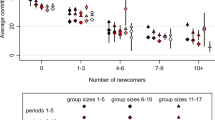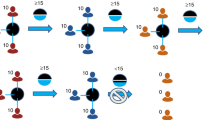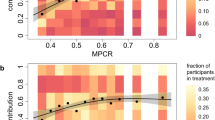Abstract
We explore the effect of fixed versus dynamic group membership on public good provision. In a novel experimental design, we modify the traditional voluntary contribution mechanism (VCM) by periodically replacing old members of a group with new members over time. Under this dynamic, overlapping generations matching protocol we find that average contributions experience significantly less decay over time relative to a traditional VCM environment with fixed group membership and a common termination date. These findings suggest that the traditional pattern of contribution and decay seen in many public goods experiments may not accurately reflect behavior in groups with changing membership, as is the case in many real-world environments.











Similar content being viewed by others
Notes
The reason for the paucity of overlapping generation experiments is likely owing to the inconvenience of having subjects enter or exit the laboratory at different times. We address this issue in our experimental design.
Indeed, as fundraising expert Burnett (2002), p. 155 writes: “Every fundraising organization needs to be recruiting new supporters constantly, if not for reasons of growth then to replace those lost through natural (or unnatural) wastage”.
They may also be reassigned between groups [as in endogenous group formation designs or real stranger protocol of Sonnemans et al. (1999)].
Another experimenter remained in the room with the remaining subjects and enforced a rule of no communication.
An alternative motivation comes from Malmendier and Nagel (2014) who report that individuals place higher weight on realizations of macroeconomic data (e.g., inflation) experienced during their life-times as compared with the available historical data prior to their birth.
Once subjects had completed their participation in a dynamic treatment session they were immediately paid in a separate room adjacent to the laboratory and were excused, i.e., they did not have to wait around for the session to end to receive their payment.
For this reason, it would be difficult to compare behavior in our dynamic treatment with behavior in a fixed match environment lasting 36 periods, as the latter would involve play of the public good game by subjects who lived 3 times longer than any subject in our dynamic treatment.
The logic of this truncation may be better understood by reference to Fig. 1.
As explained below, the dummy variable is constructed in this manner as turnover is intended to detect restart effects among existing subjects.
References
Andreoni, J. (1988). Why free ride?: Strategies and learning in public goods experiments. Journal of Public Economics, 37(3), 291–304.
Andreoni, J., & Croson, R. T. A. (2008). Partners versus strangers: Random re-matching in public goods experiments. In C. R. Plott & V. L. Smith (Eds.), Handbook of experimental economics results volume 1 (pp. 776–783). Amsterdam: North-Holland.
Brekke, Kjell Arne, Hauge, Karen Evelyn, Lind, Jo Thori, & Nyborg, Karine. (2011). Playing with the good guys. Public good game with endogenous group formation. Journal of Public Economics, 95(9–10), 1111–1118.
Burnett, K. (2002). A donor-based approach to the business of raising money. San Francisco: Wiley.
Chaudhuri, Ananish. (2011). Sustaining cooperation in laboratory public goods experiments: A selective survey of the literature. Experimental Economics, 14(1), 47–83.
Chaudhuri, A., Graziano, S., Maitra, P. (2006). Social learning and norms in an experimental public goods game with inter-generational advice. Review of Economic Studies, 73(2), 357–380.
Claudia, K., & van Winden, F. (2000). Conditional cooperation and voluntary contributions to public goods. Scandinavian Journal of Economics, 102(1), 23–39.
Dawes, Robyn M., McTavish, Jeanne, & Shaklee, Harriet. (1977). Behavior communication, and assumptions about other people’s behavior in a commons dilemma situation. Journal of Personality and Social Psychology, 35(1), 1–11.
Deck, C., David, P., Vernon, S. (2011). Double bubbles in assets markets with multiple generations. Working paper.
Dufwenberg, M., Tobias, L., & Evan, M. (2005). Bubbles and experience: An experiment. American Economic Review, 95, 1731–1737.
Ehrhart, K.-M. & Claudia, K. (1999). Mobility and cooperation: On the run. Working paper 99S–24 CIRANO, Montreal.
Fehr, E., & Gächter, S. (2000). Cooperation and punishment in public goods experiments. American Economic Review, 90(4), 980–994.
Fischbacher, U. (2007). z-Tree: Zurich toolbox for ready-made economic experiments, Experimental Economics, 10(2), 171–178.
Fischbacher, U., Gachter, S., & Fehr, E. (2001). Are people conditionally cooperative? Evidence from a public goods experiment. Economics Letters, 71(3), 379–404.
Guala, F. (2005). The Methodology of Experimental Economics. Cambridge: Cambridge University Press.
Issac, R. M., Walker, J. M., & Thomas, S. H. (1984). Divergent evidence on free riding: An experimental examination of possible explanations. Public Choice, 43, 113–149.
Issac, R. M., & Walker, J. M. (1988). Group size effects in public goods provision: The voluntary contributions mechanism. Quarterly Journal of Economics, 103(1), 179–199.
Kosfeld, M., Okada, A., & Riedl, A. (2009). Institution formation in public goods games. American Economic Review, 99(4), 1335–1355.
Ledyard, J. O. (1995). Public goods: A survey of experimental research. In J. H. Kagel & A. E. Roth (Eds.), The handbook of experimental economics (pp. 111–194). Princeton: Princeton University Press.
Malmendier, U. & Stefan, N. (2014). Learning from inflation experiences. Working paper, University of Michigan, September 8, 2014.
Marimon, Ramon, & Sunder, Shyam. (1993). Indeterminacy of equilibria in a hyperinflationary world: Experimental evidence. Econometrica, 61(5), 1073–1107.
Offerman, H. T., Potters, J., & Verbon, H. A. A. (2001). Cooperation in an overlapping generations experiment. Games and Economic Behavior, 36(2), 264–275.
Robert L., S. (2005). Competing against experienced and inexperienced players. Experimental Economics, 8, 55–75.
Samuelson, P. (1958). An exact consumption-loan model of interest with or without the social contrivance of money. Journal of Political Economy, 66(6), 467–482.
Sonnemans, J., Schram, A., & Offerman, T. (1999). Strategic behavior in public good games: When partners drift apart. Economics Letters, 62, 35–41.
Acknowledgments
We thank the associate editor and two referees for helpful comments and suggestions. We also thank the University of Pittsburgh Dietrich School of Arts and Sciences for funding this research.
Author information
Authors and Affiliations
Corresponding author
Electronic supplementary material
Below is the link to the electronic supplementary material.
Rights and permissions
About this article
Cite this article
Duffy, J., Lafky, J. Birth, death and public good provision. Exp Econ 19, 317–341 (2016). https://doi.org/10.1007/s10683-015-9439-y
Received:
Revised:
Accepted:
Published:
Issue Date:
DOI: https://doi.org/10.1007/s10683-015-9439-y




